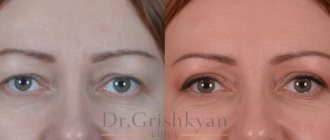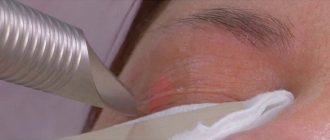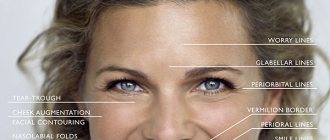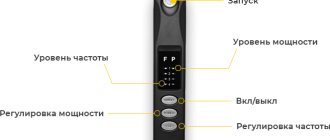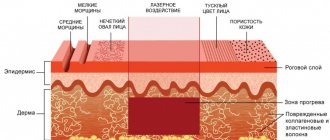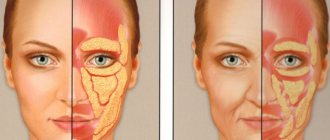In childhood and adolescence, we look at the world with wide open eyes. Many things amaze us; we eagerly explore the world and people around us. The expression of the eyes in youth is a little naive, trusting, slightly surprised. As the years pass, we accumulate experience, which, willy-nilly, is reflected on the face and, especially, in the eyes. It doesn't matter whether there were more good events or bad ones in our lives. The only important thing is what is our attitude towards these life episodes and whether we managed to remain ourselves. In adulthood, the eyes reflect not only experience, but also the character of a person. Over time, the look becomes heavy, the upper eyelids droop, and dark circles and bags form under the lower ones. Sometimes the eyes become sunken, and this gives them a mournful expression.
The good news is that everything can be fixed. You can restore radiance to your eyes, get rid of bags and dark circles under your eyes, lift your eyebrows, and get rid of drooping eyelids. To achieve a youthful look, you do not need to undergo a full-fledged operation; you can turn to a minimally invasive modern method called eyelid lipofilling .
Plastic surgery is constantly looking for safer ways to correct appearance. Lipofilling of the eyelids is one of the most progressive techniques that allows you to significantly change a person’s appearance without traumatic intervention. This technique has been appreciated by many patients, demonstrating positive results of the operation.
Eyelid lipofilling: how the operation works
Lipofilling of the eyelids is a minimally invasive surgical intervention aimed at correcting the eyelids and tissues of the periorbital area. It occurs by transplanting the patient's autologous fat graft into the area around the eyes. Lipofilling of the eyelids consists of three procedures: taking fat from the donor area, processing adipocytes (fat cells) for their better engraftment in a new place and directly introducing viable cells into a pre-designated area around the eyes.
Despite its growing popularity, lipofilling of the eyelids still raises a number of doubts about the successful outcome. The main questions that patients ask is uncertainty about the survival of fat cells. It is important to understand here that the viability of adipocytes will depend on the method of their collection from the donor part of the patient's body. The removal of fat cells is called liposuction, and it can be done using various methods. The most modern methods are those that operate on the principle of cytosparing technology (cito in Latin - cell). For example, ultrasound technology allows you to gently and without trauma separate fat cells in entire clusters (clusters) from surrounding tissues without damaging the cells themselves or nearby vessels and nerves. An ultrasonic wave of a certain frequency acts on the liquid of a previously introduced tumescent solution, the bubbles of which, bursting from ultrasonic vibrations, separate fat cells from neighboring tissues.
After separation, the fat cells enter a hollow cannula tube, and from there into a reservoir in which they will be processed. Lipofilling of the eyelids requires complete sterility of the entire operation to avoid infection of the material. If all medical protocols are followed and liposuction is performed using the latest generation equipment, the cells will remain 80-85% viable. Lipofilling of the eyelids is an operation where the doctor’s qualifications are very important, since only experience and excellent knowledge of anatomy will prevent common mistakes common to beginners. For example, donor areas are not all equally effective for transplantation into the periorbital region. Fat from the patient's knees is predominantly used, as it is most suitable for this task. It should be small enough and take root well in the facial area.
After processing the fat cells, the autograft is transplanted using the thinnest cannulas into pre-marked areas. Lipofilling of the eyelids requires a very delicate intervention; therefore, flexible cannulas with round tips are used, capable of bypassing even blood vessels and nerves. With a highly qualified doctor, hematomas and tissue trauma can be practically avoided. Access points for cannulas in the skin are minimal punctures that will not be visible after healing.
Periorbital rejuvenation/beautification
Periorbital rejuvenation/beautification includes a number of surgical interventions performed to correct age-related and constitutional changes localized in the area around the eyes:
Upper blepharoplasty
- an operation aimed at removing excess skin (true blepharochalasis), creating a more pronounced fold, volumetric correction of the upper eyelids, correction of the skin fold in the medial corner of the eye (epicanthus), correction of drooping eyelid;
Lower transconjunctival blepharoplasty
– an operation performed through an incision on the inside of the lower eyelid and does not leave visible scars, which allows you to get rid of fatty hernias in the lower eyelid area (the so-called “bags under the eyes”);
Lower percutaneous blepharoplasty
- an operation performed through an incision directly under the eyelashes, which allows you to get rid of both fatty hernias and excess skin and the orbicularis oculi muscle in the lower eyelid area;
Lower extended blepharoplasty
– an operation that allows you to both redistribute your own orbital fat contained in the “hernias” of the eyelids, and to tighten the overstretched orbicularis oculi muscle, which allows you to get rid of excessively deep nasolacrimal and eyelid-buccal grooves, the so-called paint bags and scallops;
Canthoplasty
– an operation aimed at strengthening the lower eyelid, increasing its tone by additional fixation of the weakened external angular ligament of the eye, as well as preventing drooping and eversion of the lower eyelid when removing significant excess skin and in the presence of risk factors for this complication. The shape of the eyes does not change. With the so-called “dynamic” canthoplasty, the outer corner of the eye is moved to a more aesthetically attractive high position, which allows both to achieve the popular “fox” eye effect and to correct the most severe atony, eversion and drooping of the lower eyelid. Most often, canthoplasty is performed as part of extended blepharoplasty;
Eyebrow lifting
– an operation aimed at correcting the position of the eyebrows when they are drooping and/or asymmetry, which is often accompanied by the formation of excess skin over the fold of the upper eyelid (false blepharochalasis). The following options for this intervention are possible:
- direct eyebrow lifting, when a strip of skin is excised directly along the upper border of the eyebrow, which allows you to hide scars at the border of the hair;
- endoscopic lifting, when the lift is performed by mobilizing the entire tissue mass of the frontotemporal region, moving and fixing it in a higher position using endoscopic technology through several small incisions in the scalp.
Lipofilling of eyelids: varieties
Lipofilling of the eyelids can be performed for both the upper and lower eyelids. Upper eyelid surgery can remove drooping eyelids and lift the brow. Due to the additional volume of the upper eyelid, the eye opens and small expression wrinkles are smoothed out. When the eyes are sunken, the volume added to the upper eyelid fills the sunken part of the eye and rejuvenates the surrounding tissues.
Eyelid lipofilling, performed on the lower eyelid, removes bags under the eyes and dark circles as the skin becomes denser and firmer, taking on all the qualities of a youthful appearance. Often, eyelid lipofilling is combined with blepharoplasty for a more pronounced result. Among the supporting cosmetic procedures after surgery, laser resurfacing of the skin of the periorbital area can be recommended, which allows you to quickly get rid of blue under the eyes, age spots and small facial wrinkles. If the patient’s skin is elastic and young enough, capable of retraction (contraction), additional procedures may not be performed, since the patient’s own fat graft, taking root and sprouting new blood vessels, has a rejuvenating effect on the surrounding tissue.
Lipofilling of the eyelids is sometimes combined with lipofilling of the tear trough. This operation is also performed with very thin cannulas, so there is no need for sutures, and the trace of a small puncture will be completely invisible. The technique for introducing the autograft is fan-shaped, which allows the fatty material to be laid out delicately and thinly under the skin. Some specialists use a thinner filling material in this delicate area, supplementing it with enriched blood plasma.
Eyelid lipofilling: complications, rehabilitation period and contraindications
Lipofilling of the eyelids is a unique operation of its kind in terms of safety and short rehabilitation period. Anesthesia during surgery can be either local or general, depending on the indications. Complications, although they are rather an exception, nevertheless occur, about which the doctor is obliged to warn the patient. They manifest themselves in long-term hematomas if a vessel was damaged, clumping of fat if the technique was incorrect, lumpiness if the fat was injected incorrectly and in violation of the protocol, resorption of a large part of the fat if the patient smokes without complying with the requirements of the recovery period. Major complications occur due to physician errors or patient indiscipline. So the doctor’s experience and qualifications in lipofilling are extremely important; the outcome of the operation and the aesthetic effect will depend on them.
Eyelid lipofilling has a short recovery period. It is characterized by minor bruising and swelling, which will resolve within a week or even faster, depending on the patient's data. Considering that fat itself has a powerful wound-healing and rejuvenating effect, the postoperative period is tolerated quite easily by patients. There are no stitches; instead, thin strips of adhesive are used, which are removed the next day, so that the patient can evaluate the result immediately after the operation. It is not necessary to stay in the clinic if there are no complications; the patient is allowed to leave a few hours after the operation. In the case of general anesthesia, you will have to wait until the body functions are fully restored. It is recommended to strictly adhere to the schedule of postoperative visits to the doctor to avoid the development of complications. The final result of the operation is assessed after two months. This is exactly the period needed to estimate the percentage of surviving fat. If correction is necessary, experts do not recommend carrying it out earlier than six months after the first intervention.
Despite the fact that lipofilling of the eyelids is a low-traumatic operation and is a minimally invasive intervention, there are certain restrictions imposed in the postoperative period. You should avoid physical activity for a month, and also not expose yourself to strong temperature changes. In addition, it is necessary to stop drinking alcohol, tobacco, follow a decongestant diet, and also eliminate medications that affect hematopoiesis. Experts also do not recommend gaining weight or losing much weight by more than 10% of your body weight, since the transplanted fat behaves like normal fat and reacts to the patient’s lifestyle. If these conditions are met, the effect of lipofilling will last a lifetime.
Lipofilling of the eyelids is the most modern way to change your appearance using a low-traumatic method with the shortest recovery period. In just a week you can go to work with “new” eyes, as if you had just arrived from a resort. Most patients show great satisfaction from the operation and change before our eyes, which is clearly visible in the photographs before and after the operation. The look becomes more open and youthful, and satisfied patients literally beam with joy from the wonderful transformation.
Lipofilling eyelids
It happens that after rapid weight loss or due to hereditary characteristics, circles and “dips” form around the eyes, the eyes seem sunken inward, which makes the face look older not by a year or two, but by entire decades. And no cream in the world can solve this problem. After all, with age, subcutaneous adipose tissue is lost, which gives volume to facial features, making them round and pleasing to the eye.
Lipofilling can solve the problem of “sunken” eyes. During this procedure, doctors fill the patient's own fatty tissue into those places on the body where it is lacking, in this case the eyelids. To do this, several milliliters of fat are taken from the inner surface of the thigh or abdomen, processed in a special way and injected under the skin of the eyelids. As a result of replenishing the volume, the drooping corners of the eyes rise, voids and circles under the eyes disappear, the face takes on a more welcoming expression and a youthful appearance, and not for six months, but up to two years!
Why is lipofilling of the eyelids better done at the Beauty Trend clinic?
- the procedure is completely safe, low-traumatic, there are no age restrictions, has a minimum of contraindications, can be performed on almost any part of the body that needs correction, and does not require long rehabilitation. It only takes about a week to fully recover. During this time, the puncture sites where the adipose tissue was “taken away” heal, and minor swelling disappears where it was transplanted;
- To improve the appearance, no fillers or acids are used, but only the patient’s own fat tissue. Everything is as natural and safe as possible, the risk of allergies or rejection is zero;
- for a visible reduction of wrinkles, smoothing and tightening of the skin, giving the necessary volume, only one procedure is needed;
- the result of lipofilling, no matter what part of the body it was performed on, looks as natural and natural as possible;
- the positive result of lipofilling “accumulates” over two months and lasts for up to two years, after which the technique can be repeated;
- In our clinic, the lipofilling procedure is performed by experienced doctors who have been trained in Russia and abroad, constantly practice and improve their skills.
Interested? Our clinic specialists will answer all your questions and assess the need for correction in your case. Sign up for an in-person consultation by phone (495) 411-03-03
The procedure is carried out.
- Zlenko Vladimir Aleksandrovich Plastic surgeon, Candidate of Medical Sciences. More than 7 years of experience.
- Lonskaya Ekaterina Aleksandrovna Plastic and maxillofacial surgeon, laser surgeon. More than 6 years of experience.
- Andryushchenko Olesya Anatolyevna Plastic surgeon, Candidate of Medical Sciences. More than 15 years of experience.
Types of lipofilling
- Facial lipofilling
- Lipofilling of lips
- Breast lipofilling
- Lipofilling eyelids
- Lipofilling of the buttocks
- Lipofilling of cheekbones
- Lipofilling of the legs
- Chin lipofilling
- Cheek lipofilling
- Hand lipofilling
- Lipofilling of legs
- Lipofilling of thighs
- Nasal lipofilling
